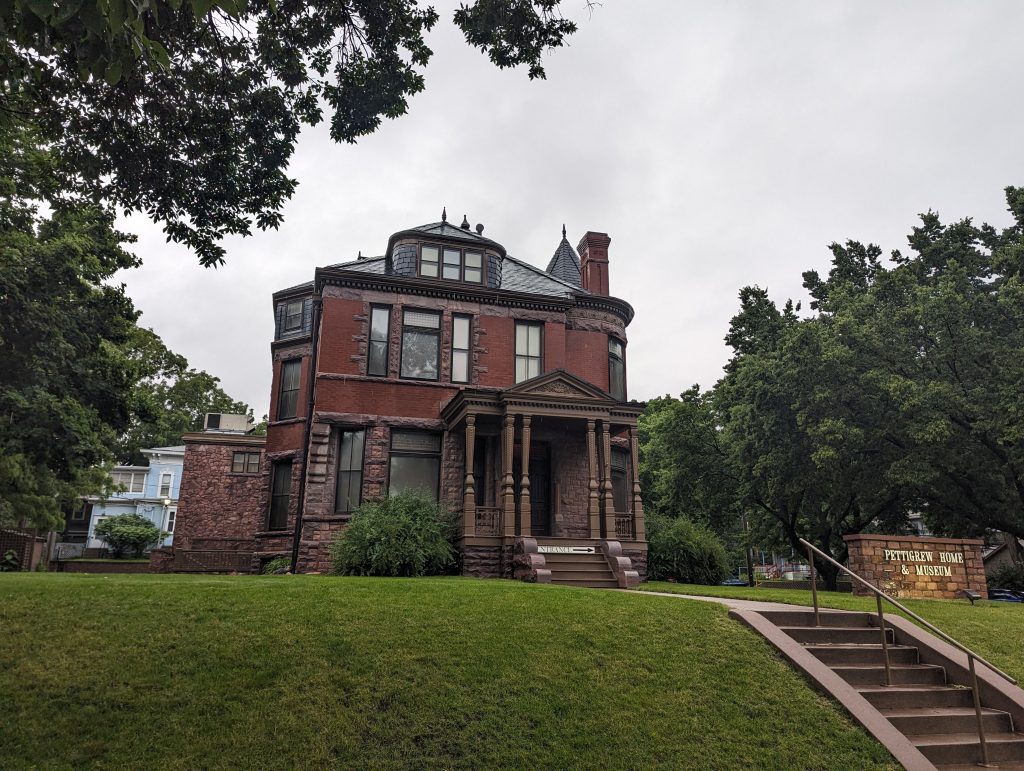As a responsible citizen, I traveled back “home” to Sioux Falls in order to perform my civic duties and serve as a juror. This gave me the chance to check out some of the sites and tastes of the city.
Old Courthouse Museum
Once my duties were complete at the current Minnehaha County courthouse, I walked down the street to the Old Courthouse Museum. Built from 1889-1983, the building was designed by local architect Wallace L. Dow to be the largest courthouse between Chicago and Denver. It was in use by the county courts until 1962 when a new, much larger court facility was built just a block away. Originally, the courthouse was intended to be razed in order to create a new parking lot, but concerned citizens effectively saved the building and turned it into a museum.
Today, the museum hosts a series of permanent and temporary exhibits related to local history, but a highlight of a visit is the building itself. Built of native Sioux Quartzite stone, the building and its clock tower are prominent on the downtown Sioux Falls skyline.


Inside, walls, stairwells, and hallways feature 16 murals by Norwegian immigrant painter Ole Running who was paid $500 for the work. Running painted the murals from 1915 to 1917 featuring scenes from life in the Dakotas and natural sites. The murals are delicate and detailed, and some include humorous elements. Most of the murals have been conserved and restored, but some are still awaiting funds for full restoration,


The painted details in the courtroom itself are especially pleasing and have been restored to their original pristine condition. The header image also highlights the impressive courtroom decoration.





At the turn of the 20th century, the courthouse was the scene many notorious divorce trials. Due to its liberal (for the time) divorce laws, South Dakota was known as the “Divorce Colony” and people traveled from states with more stringent laws (or that prohibited divorce outright!) in order to legally dissolve their marriages. We listened to The Divorce Colony: How Women Revolutionized Marriage and Found Freedom on the American Frontier (affiliate link) by April White which describes this period in South Dakota history.
R.F. Pettigrew House
Richard Franklin “Frank” Pettigrew was a 19th century politician, world traveler, civic booster, collector, and business tycoon from Sioux Falls. He was the Dakota’s representative to the U.S. and then was elected as South Dakota’s first full-term senator in 1889 when the state was admitted to the Union. He served two terms in Congress, notable for leaving the Republican party over its support of the monetary gold standard which he said was due to the influence of bankers and wealthy east coast businessmen and contrary to sound fiscal policy.
Later, Pettigrew would claim that U.S. intervention into World War I was being promulgated by wealthy people who saw military conflict as a means to make money, and urged young men to avoid the draft. The local U.S. Attorney secured a felony indictment of Pettigrew for violations of the Espionage Act of 1917. Pettigrew claimed that his constitutional right to free speech allowed him to speak out, and engaged the services of Clarence Darrow. Eventually, the case was dropped, which Pettigrew claimed as a victory, framing the original indictment and hanging it next to a copy of the Declaration of Independence in his home.


In 1911, Pettigrew bought an elegant though not especially large home from Thomas and Jenny McMartin on 8th Street in Sioux Falls. Built in 1889 for the newly-wed McMartins, Pettigrew evidently found the home sufficient for his wife and two sons in most respects — with the exception of room for his collection of artifacts and artworks. (More on this below.)






Pettigrew left his home to the city of Sioux Falls in his will. The Pettigrew Home & Museum is maintained today by the city of Sioux Falls.
R.F. Pettigrew Museum
One of R.F. Pettigrew’s great passions was his collecting. He was a world traveler as well as an amateur archaeologist, and so compiled a very large collection of stone tools, projectile points, Native American clothing, guns, natural history specimens, and items related to the settlement of Sioux Falls.
To accommodate this collection, Pettigrew tore down the porch on the back of the house, and added a two-story addition where he could display his with the exception of room to showcase his archeological artifacts, artwork, historical items, and curiosities that he collected in his worldwide travels.. Today, this is the “Museum” portion of the R.F. Pettigrew House and Museum.


In addition to the oddities of Pettigrew’s collection, much of the museum is also devoted to the history of Sioux Falls, especially the large number of historic home that remain in the city.






